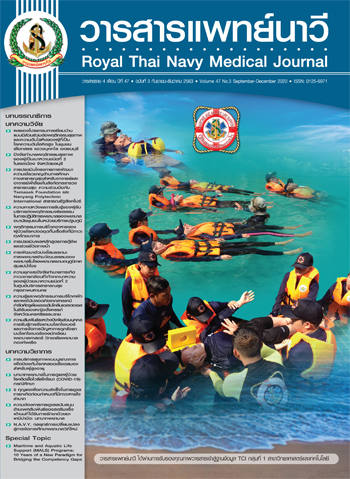5-Key to Success in Nursing Care of the Premature Babies with Respiratory Distress Syndrome
Main Article Content
Abstract
Respiratory Distress Syndrome (RDS) is a public health problem which commonly exhibits breathing difficulties, respiratory failure, and long-term complications particularly in premature babies. Therefore, the aim of this article is to present the guideline of nursing care for premature babies who have RDS under evidence-based practice. The 5-key to success guideline was created for nurses to follow which included: 1) Maintaining the oxygenation adequately and safely, 2) Promoting effective lung expansion, 3) Keeping the airway clear, 4) Maintaining normal body temperature, and 5) Maintaining adequate nutrition. The goal of 5-Key to success are to keep babies safe from respiratory failure, prevent the development of complications that may arise both in the acute phase and in the long term, strengthen the function of the lungs and support the baby to continue growing with the least possible abnormalities.
Article Details

This work is licensed under a Creative Commons Attribution-NonCommercial-NoDerivatives 4.0 International License.
References
2. Saboute M, Kashaki M, Bordbar A, Khalessi N, Farahani Z. The incidence of respiratory distress syndrome among preterm infants admitted to neonatal intensive care unit: a retrospective study. Open Journal of Pediatrics 2015;5(4):285-9.
3. World Health Organization. World health statistics 2019: monitoring health for the SDGs, sustainable development goals. Geneva: WHO; 2019.
4. Chuachuensuk S, Lumbiganon D. Incidence and factors associated with early respiratory distress in late preterm infants. Vajira Med J. 2019;63(2):93-106. (in Thai).
5. Fraser D. Health Problem of Newborns. In: Hockenberry MJ, Wilson D, Rodgers, CC, editor. Wong’s essentials of pediatric nursing. Canada: Elsevier 2017. p. 229-301.
6. Ramenghi LA. Late preterm babies and the risk of neurological damage. Acta Biomed, AMB. 2015;86(Suppl 1):36-40.
7. World Health Organization. Born too soon: the global action report on preterm birth. [Internet]. [cited 2020 March 15]. Available from: https://www.who.int/pmnch/media/news/2012/201204_borntoosoon-report.pdf.
8. Chawanpaiboon S, Vogel JP, Moller A-B, Lumbiganon P, Petzold M, Hogan D, et al. Global, regional, and national estimates of levels of preterm birth in 2014: a systematic review and modelling analysis. The Lancet Global Health 2019;7(1):e37-e46.
9. Kimberly F. The high-risk newborn and family. In: Hockenberry MJ, Wilson D. Wong's nursing care of infants and children. [Internet]. 11th ed. MO: Elsevier Health Sciences; 2018. p. 296-309. [cited 2020 March 9]. Available from: https://evolve.elsevier.com/cs/product/9780323485098?role=student.
10. Hermansen CL, Mahajan A. Newborn respiratory distress. AFP 2015;92(11):994-1002.
11. Jing L, Yun S, Dong J-y, Zheng T, Li J-y, Lu L-l, et al. Clinical characteristics, diagnosis and management of respiratory distress syndrome in full-term neonates. Chinese Medical Journal. 2010;123(19):2640-4.
12. Sweet DG, Carnielli V, Greisen G, Hallman M, Ozek E, Te Pas A, et al. European consensus guidelines on the management of respiratory distress syndrome-2019 update. Neonatology 2019;115(4):432-50. DOI: 10.1159/000499361: 10.1159/000499361.
13. Manja V, Saugstad OD, Lakshminrusimha S. Oxygen saturation targets in preterm infants and outcomes at 18-24 months: a systematic review. Pediatrics 2017;139(1):e20161609. DOI: 10.1542/peds.2016-1609.
14. Armanian A-M, Iranpour R, Parvaneh M, Salehimehr N, Feizi A, Hajirezaei M. Heated Humidified High Flow Nasal Cannula (HHHFNC) is not an effective method for initial treatment of respiratory distress syndrome (RDS) versus nasal intermittent mandatory ventilation (NIMV) and nasal continuous positive airway pressure (NCPAP). J Res Med Sci 2019 Aug 28;24:73. doi: 10.4103/jrms.JRMS_219.
15. Ramanathan R, Sekar KC, Rasmussen M, Bhatia J, Soll RF. Nasal intermittent positive pressure ventilation after surfactant treatment for respiratory distress syndrome in preterm infants <30 weeks' gestation: a randomized, controlled trial. Journal of Perinatology 2012;32(5):336-43.
16. Polin RA, Carlo WA. Surfactant replacement therapy for preterm and term neonates with respiratory distress. Pediatrics 2014;133(1):156-63.
17. Guay JM, Carvi D, Raines DA, Luce WA. Care of the neonate on nasal continuous positive airway pressure: a bedside guide. Neonatal Network 2018;37(1):24-32.
18. Schreiber MD, Marks JD. Noninvasive ventilation in the premature newborn—is less always more? N Engl J Med 2017;377(4):386-8.
19. Huston RK, Markell AM, McCulley EA, Pathak M, Rogers SP, Sweeney SL, Dolphin NG, Gardiner SK. Decreasing necrotizing enterocolitis and gastrointestinal bleeding in the neonatal intensive care unit: the role of donor human milk and exclusive human milk diets in infants≤ 1500 g birth weight. ICAN: Infant, Child, & Adolescent Nutrition 2014;6(2):86-93.
20. Kenaphoom S. Approaches for writing the academic article. Humanities and Social Sciences 2017;34(1):1-31. (in Thai).
21. Pirunnet T. Strategies for early weaning invesive ventilatory support: general care and adjunctive therapies. In: Punnahitananda S, Limrungsikul A, Tongsawang N, editors. Good clinical practice in neonatology. Bangkok: Thai Neonatal Society; 2017. p. 162-92. (in Thai).
22. Jirapaet V. Respiratory care in Infant with bronchopumonary dysplasia. In: Punnahitananda S, editor. Practical point and update in neonatal care. Bangkok: Thai Neonatal Society; 2019. p. 211-24. (in Thai).


